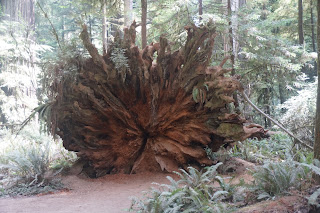THURSDAY,
AUGUST 27:
A gorgeous day – sunny,
perfect warm temperature in the 70's. We took advantage and
walked/hiked in 2 different redwood groves, both in Jedediah Smith
Redwoods State Park. Actually, we had passed through this stretch
last year on our way down from the Oregon coast and back up to Grants
Pass, and were blown away by our unexpected short encounter with the redwoods. Still blown away! As the Park pamphlet ssays, “Remaining Coast Redwood forests grow naturally only in a narrow strip along the Pacific coastline from central California into southern Oregon. Jedediah Smith Redwoods State Park proects 10,000 acres of these first-growth primeval treasures.”
About halfway through our walk on the Simpson Reed trail, we ran into a Park Ranger. We just started talking, and before long, it was like we had our own private Ranger-led hike, one of our very favorite ways of experiencing our national parks. Ranger Mike explained why this Redwood grove, typical of most, has lots of secondary and tertiary trees (conifers and hardwoods, respectively), as well as lots of brushy undergrowth.
Exposed roots of a tree blown over:
He also explained why Redwoods
live so long - their inner layer contains tannin, an acid, which is
highly resistant to insects, fungi, and rot; the trees are also
highly resistant to fire because they contain no pitch. He said that
it's very fortunate that these trees are so hardy, in that there is
ever increasing “poaching” of their burls – the knobby growths
usually seen near the base of the trunks, which often have complex
and uniquely patterned wood grains.
They're highly prized for
furniture and artwork, worth thousands of dollars, and people come
into the parks at dark and illegally cut them off of the trees,
leaving huge scars. This would leave most trees very susceptible to
insect and fungi damage, leading to death. But, unless the damage is
severe, most Redwoods can heal. Nevertheless, it's sickening to
think of the wanton disrespect those thieves have for these
magnificent showpieces of nature. He said that they have been able
to trace a few of the stolen burls, and have successfully prosecuted
some. However, the approach that the NPS is really taking in order
to combat this is to educate and rally public support -e.g., if
you're about to purchase an object fashioned out of Redwood burl, ask
what the source is. If the seller doesn't know, pass on it.
Our second walk was through the
Stout Grove. Because this grove is situated near a river, it
periodically becomes flooded, and therefore prevents much of the
understory growth. As a result, the old growth Redwood trees
themselves are showcased here maybe better than anywhere else in the
world. Walking through this forest, it almost had a cathedral-like
feel to it, hushed and serene, dappled in sunlight as though through
stained-glass windows.
And a feel of mystery, too, when
the canopy obscured the sun.
Or when we came across really monster-resembling burls.
A real contrast when we came out
of the woods into the warm, bright sunshine shining on the crystal
clear river.
A really, really nice day
enjoying these easy walks through sublime and awesome beauty.




















No comments:
Post a Comment